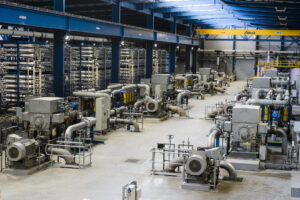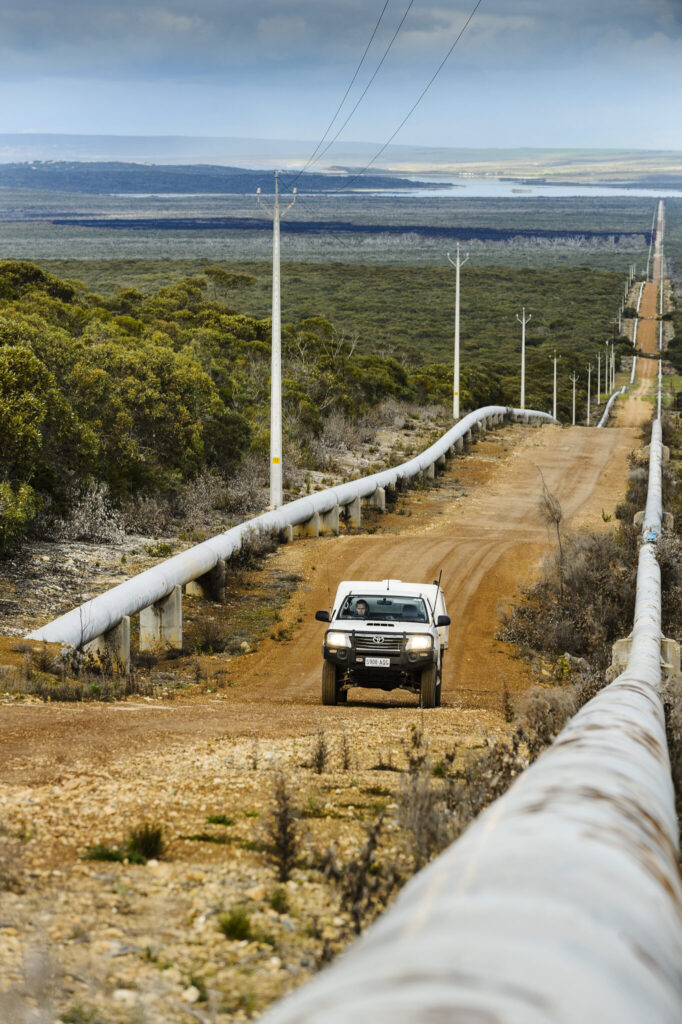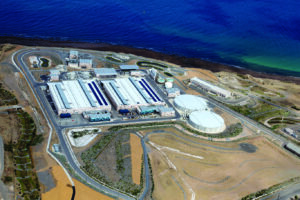SA Water has been supplying water to the people of the Australian state of South Australia for over 150 years. South Australia’s 1.7 million residents are spread across an area more than twice the size of California, meaning that SA Water’s infrastructure is extremely extensive, reaching into remote zones. The Millennium Drought of the early to mid- 2000s has pushed SA Water and its customers to become more water efficient and to develop alternate water sources, including desalination plants.
Catrin Moller: Please tell us about your background and how you came to be in your current position.
Anna Jackson: Twenty-five years ago, when I started working for the Australian national broadcaster as a journalist, it never occurred to me that I would end up in the water industry. Growing up in Adelaide, I just turned on the tap and expected water to come out and flushed the toilet and expected everything to go away, as I think most people do. Then I worked in politics, public affairs, and government advocacy for a long time. I transferred into the private sector, working on emerging markets, and that morphed into international development, which brought me to work in Washington, DC, including with a U.S. company called Tetra Tech International. I ended up at SA Water, attracted by the provision of essential services. Whether you are working in international development or human rights management, water and wastewater management is important for every single thing that you do.
Catrin Moller: Please tell us about SA Water.
Anna Jackson: SA Water is an interesting organization that is similar to only one other Australian water utility— the one in Western Australia—in terms of governance, remit, and size. It is a publicly owned water corporation, which means that it is designed to be a commercial operation while being owned by the government of South Australia. It has an independent board reporting to the minister for environment and water. We have to look at things in both a commercial and a social light because of this arrangement—it’s really important that we get that balance right all the time. We work closely with the government to make sure that we can provide water and wastewater services for as many South Australians as possible. We have 700,000 residential and business connections in South Australia. There are 1.7 million people in South Australia. Some South Australians receive water through smaller organizations or councils, but SA Water supplies the majority of the state.

In 1881, Adelaide was the first city in Australia to use a water-based, deep-drainage sewerage system. We set up one of the first wastewater treatment plants in the Southern Hemisphere as well. We’ve always had innovation and public health at our heart.
Kris Polly: What is the population of Adelaide?
Anna Jackson: The population of Adelaide is 1.2 million, and the population of South Australia is 1.7 million. That makes it a medium- sized Australian state in terms of population. Our facilities reach remote areas across the state. As a result, we have 27,000 kilometers of water mains, making ours the longest network in Australia.
Catrin Moller: Is there anything else you wanted to add about the history of SA Water?
Anna Jackson: SA Water has a reputation for being rather conservative, which is appropriate for a provider of essential services, but in actual fact, there’s a lot of innovation in our corporation. If you visit our building here in Adelaide, we have scientists with cutting-edge water quality expertise inventing things all the time. We have people working closely with the community and the agriculture industry to deal with wastewater byproducts. Throughout the organization, from the person digging a trench to fix a water main to the person doing water quality testing in our labs, there’s a sense of integrity and a sense of trying to do the right thing by the public. We all know that the way you manage your water supply and the way you manage your wastewater is of paramount importance to public health.
Catrin Moller: Where does SA Water’s water come from?
Anna Jackson: The main source of Adelaide’s water is a series of reservoirs in Adelaide’s hill zone, which is called the Mount Lofty Ranges. Adelaide is an interesting city in terms of layout: It is sandwiched between a zone of hills and the coast, so it’s a long, thin city, stretching in a band from north to south without spreading out much east to west.
We have the ability to pump water from the River Murray under a critical human needs water license, which is really important to us. The river goes through three other states before it gets to South Australia, and there’s a lot of discussion, debate, and argument at the moment around the way it is used upstream of us. We pump River Murray water into our reservoirs and send it through our treatment plants. The third water source we have for Adelaide is the desalination plant we built during the Millennium Drought, which is an extremely important part of our water source mix. Elsewhere across the state, we operate eight additional desalination plants—one seawater plant and seven groundwater plants.
We have an excellent mix of water sources. Most states rely on one source or another, but because we’ve got three, we can really mix things around depending on the circumstances and the climatic conditions.
Catrin Moller: What effect has the Millennium Drought had on South Australia and SA Water?
Anna Jackson: What’s happened as a result of the Millennium Drought from a community point of view is that people value water as a resource a lot more than they used to. I was living in Canberra at the time of the drought, and at that point Canberra had been under water restrictions for quite a while. I moved back to Adelaide just as the water restrictions hit here. The community was outraged at the beginning, but it quickly came to understand the rationale for the restrictions and became more efficient and careful with water. People became water conscious. During the drought, if someone here saw one of their neighbors washing their car on a brick driveway, they would go over and say, “You can’t do that. You’re wasting water. It’s going straight down the drain.” We have a big gardening community in Adelaide and a lot of pride in our green spaces, and whole gardens changed as a result of the drought. Residents started tapping bores and investing in bore water in their backyards, with notices saying, “Garden watered by bore water,” on the fence. The community pretty much stuck to the restrictions, long after they ceased to be officially enforced.

We continue to give out water efficiency messages, and people tell us they appreciate them and work out how to use them. It’s not about water restrictions for us anymore—it’s about how to use water efficiently and in the smartest way possible. We have specific initiatives to make sure that our residential customers and business customers are not unknowingly wasting water, for example, through an automated irrigation system or an unidentified leak in their internal pipework. The flip side of that is that if infrastructure issues result in noticeable leakage from our side of the network, local communities become annoyed and let us know quickly. The conservation mindset has definitely stayed.
In terms of the management of drinking water, the Adelaide Desalination Plant is incredibly important. I remember that when Cape Town, South Africa, was facing Day Zero—the day when its municipal water supplies would run out—there was an Australian Financial Reviewarticle that said that there were two cities that would never reach Day Zero. They were Perth and Adelaide, both of which have desalination plants. Adelaideans haven’t experienced a full drought since the building of our desalination plant, and many people still do not realize that we use it almost every day. Aside from a period of time during which it is shut down for maintenance, it is up and running year round. Desalinated water from the plant is pumped along a transfer pipeline to storage tanks at our Happy Valley Water Treatment Plant, where it is blended with treated water from the Happy Valley reservoir and delivered to customers. If you are drinking Happy Valley water, and 50 percent of Adelaideans are, you’ve probably had a little bit of desalination water in your blend.
Kris Polly: What percent of your water supply comes from the desalination plant?
Anna Jackson: The plant can supply around 50 percent of the metropolitan area of Adelaide on an average day, but we do not do that all the time. We run it at 10 percent of its capacity the majority of the year and increase that as necessary. A few weeks ago, the reservoirs were getting low, so we ratcheted it up to around 25 percent of its capacity. Desalination is the most expensive way for us to produce water because it uses so much electricity. Electricity prices in Australia are high at the moment. SA Water is working on another initiative called Zero Cost Energy Future. It’s tied directly to how we manage our water sources. We’re putting 500,000 solar panels on our side of the electricity meter, at our own sites. This enables us to use all the energy that is generated to run our facilities, including treatment plants, before any is exported to the grid. Our electricity costs are currently around A$60 million (US$41 million) per year. The more we can bring electricity costs down, the cheaper it is for us to supply water in the long term.
Catrin Moller: What are the challenges that SA Water has faced during this time?
Anna Jackson: The desalination plant was a political discussion point. It was a big financial investment for the state. We were originally going to build a 50-gigaliter- per-year (40,536-acre-foot-per-year) plant but ended up going for a 100-gigaliter (81,071-acre-foot) one because it was more cost effective. The plant was not without its

controversy, and water prices initially did go up as a result of its construction. Some South Australians do not necessarily yet see the value in it the way the water professionals do, though some do and express the view that we are well prepared for the next drought. We conduct regular community, industry, and school tours, in which we take people through the plant and explain how we use it and how important it is for our security supply, and people will say, “I understand now.” The desalination plant has guaranteed the business community a reliable supply, despite potential drought. This is attractive from an economic-growth and investment perspective in a very dry country.
Sydney just announced water restrictions again, and the east coast of Australia has been heading into drought, and I’m starting to get requests for interviews about whether we are considering restrictions as well. We tell them, “We always want people to use water efficiently and carefully, but we are not considering restrictions because of our desalination plant.” This resource absolutely helps.
Kris Polly: Doesn’t Sydney have a desalination plant?
Anna Jackson: Sydney does have a desalination plant, which it in fact just turned on as well. Sydney runs its plant differently. It leaves it off, which means that when it wants to run it, it takes time to get it up and running again. It doesn’t switch on overnight. That is one of the reasons we keep our plant running in minimum mode, even if we don’t need it every month. It’s much more cost efficient to increase its output to 20 or 50 percent. We could do that tomorrow if we wanted to.
Catrin Moller: Would you comment on the steps that SA Water has taken throughout the community to maintain water security?
Anna Jackson: I mentioned that SA Water has a strong focus on innovation. One of the things our team handles are some water and sewerage services in the Anangu Pitjantjatjara Yankunytjatjara (APY ) Lands, which encompass many Aboriginal communities in the far north of the state. It’s remote—1,700 kilometers from Adelaide. There are no pipelines for water from the River Murray or anything like that. You have to think about different ways to find water. Beginning during the drought, we started projects to address the water needs of these communities. In the APY Lands, we have several solar-powered bores. We also need to use durable equipment that can stand the area’s extreme heat and can be operated remotely. Facing these challenges inspires innovations that can then be applied in a variety of ways across the state. In the future, if we have water restrictions or issues, we know we’ve got the technology to do localized solutions.
Catrin Moller: What lessons have you learned from the Millennium Drought?
Anna Jackson: Resilience is really important. We need to be on top of things like network losses and infrastructure management so that people don’t feel that we are wasting water. We are the second-biggest recycler of wastewater in Australia after Sydney, which we’re really proud of. We do a lot of work with the agricultural community. For example, we supply quality treated wastewater from several of our wastewater treatment plants for use in irrigating and growing vegetables and grapevines. We would like to do more and find more cost-effective ways to do that.
I think the mindset here is, “Try to use it.” If we are treating the water, we may as well use it to water parks and gardens rather than discharge it into the sea. In fact, we do that right across the city of Adelaide with water from one of our major wastewater treatment plants. We’re always looking at ideas and innovations like that.
Anna Jackson is the general manager for customers, strategy, and innovation at SA Water. For more about SA Water, visit sawater.com.au.
